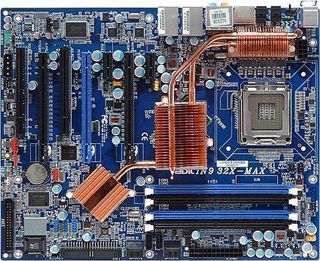More Than Just a 'Paper Launch': 680i Motherboard Comparison, Part 1
Abit IN9 32X-MAX
Abit sent the first finalized IN9 32X-MAX its representatives could get their hands on. Because the first few parts of a batch are meant for internal testing purposes, we got this board without a revision number or retail BIOS, but the beta BIOS we received was spot-on for frequencies and timings.
Feature Overview
Abit uses a digital VRM for enhanced CPU stability, especially when overclocking. Some of these components are covered by the upper portion of a three-pipe copper cooler that services the Northbridge and Southbridge as well.
The IN9 32X-Max makes room for seven expansion cards via two full-bandwidth PCI-Express x16 slots, one PCI-Express x16 slot with x8 pathways, two PCI slots and two PCI-Express x1 slots. Support for three PCI-Express graphics cards with two in SLI mode is the norm for 680i SLI chipset motherboards.

Layout conveniences include 24-pin ATX and eight-pin ATX12v connectors located on the front and top board edges, adequate clearance between DIMM latches and the back of a top-mounted graphics card, and the use of all seven slot positions to enhance support for add-in cards.
Serial ATA and Ultra ATA connectors are all turned parallel to the board for added clearance beneath longer cards, but whether or not this is a great idea depends mostly on your chassis design. Many cases, for example, have a drive cage in close proximity that may block access to these locations.
Our only real complaints are the floppy connector placement along the lower edge and the front panel audio connector in the lower rear corner. Floppy drives might be an afterthought for such a cutting-edge board, but top-mounted audio bay users will be forced to stretch their cables past all cards and pray that said cables are long enough.
Added features include "Port 80" diagnostics display and power/reset buttons located roughly midpoint along the motherboard's lower edge. The former feature should be especially handy for overclockers, while the latter is more important for technicians, reviewers and other testers who run an open platform.
Stay on the Cutting Edge
Join the experts who read Tom's Hardware for the inside track on enthusiast PC tech news — and have for over 25 years. We'll send breaking news and in-depth reviews of CPUs, GPUs, AI, maker hardware and more straight to your inbox.
| Abit IN9 32X-MAX (First Revision) | |
|---|---|
| Northbridge | Nvidia 680i SLI (C55XE) |
| Southbridge | MCP55XE |
| Voltage Regulator | Digital, Five Phases |
| BIOS | M622A-10.A08 (12/01/2006) |
| 266.6 MHz (FSB1066) | 266.6 MHz (+0.0%) |
| Connectors and Interfaces | |
| Onboard | 3x PCIe x16 (1 with x8 pathways)2x PCIe x12x PCI3x USB 2.0 (2 ports per connector)2x IEEE-1394 FireWire1x Floppy1x IDE6x SATA 3.0Gb/s1x Front Panel Audio1x CD-In1x S/P-DIF Out1x Fan 4 pins (CPU)5x Fan 3 pins (System)1x Clear CMOS Jumper1x LED "Port 80" Display1x Power Button1x Reset Button |
| IO panel | 2x PS2 (keyboard + mouse)2x Network4x USB 2.02x eSATA1x Clear CMOS Switch1x Digital Audio In (optical)1x Digital Audio Out (optical)6x Analog Audio (7.1 Channel, Mic-In, Line-In) |
| Mass Storage Controllers | |
| MCP55XE | 6x SATA 3.0Gb/s (RAID 0,1,5,10)1x Ultra ATA-133 (2-drives) |
| Silicon Image SIL3132 | 2x External SATA |
| Network | |
| Dual NVIDIA Gigabit Network | 2x Marvell 88E1118-MNC1 PHY |
| Audio | |
| HDA (Azalia) Controller Interface | Realtek ALC888 7.1 Codec |
| FireWire | |
| Texas Instruments TSB43AB22A | 2x IEEE-1394a (400 Mb/s) |
The IN9 32X-MAX features Realtek's HDMI-Compliant ALC888 7.1-channel audio codec with digital optical input and output on the back panel. Two eSATA ports interface its SLI3132 add-in SATA controller, but the TSB43AB22A IEEE-1394 FireWire 400 interface is only accessible via break-out panels to internal headers.

Most Popular


